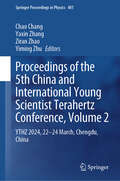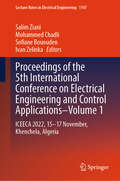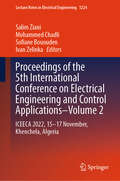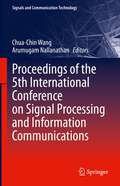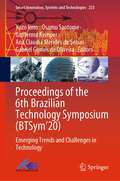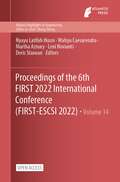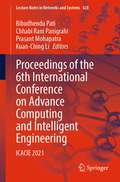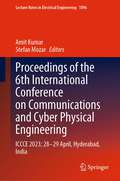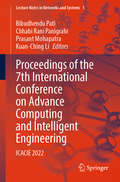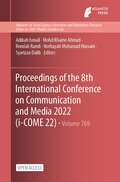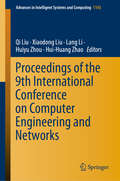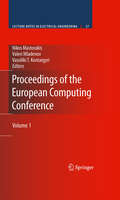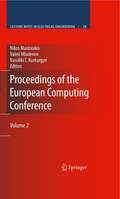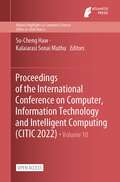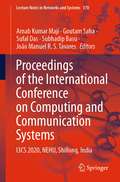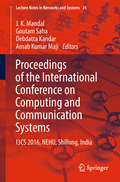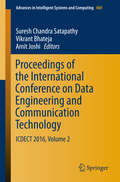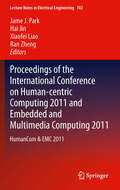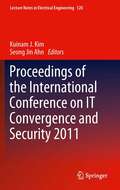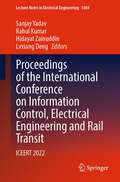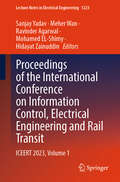- Table View
- List View
Proceedings of the 5th China and International Young Scientist Terahertz Conference, Volume 2: YTHZ 2024, 22-24 March, Chengdu, China (Springer Proceedings in Physics #401)
by Chao Chang Yaxin Zhang Ziran Zhao Yiming ZhuThe Proceedings of the 5th China and International Young Scientist Terahertz Conference highlight the important research and technological progresses on terahertz signal sources, terahertz detection, terahertz biophysics, terahertz transmission, terahertz regulation, terahertz device and materials, terahertz communication, terahertz radar and imaging, terahertz spectroscopy and biotechnology, and the intersection and application of terahertz-related disciplines.
Proceedings of the 5th International Conference on Electrical Engineering and Control Applications–Volume 1: ICEECA 2022, 15–17 November, Khenchela, Algeria (Lecture Notes in Electrical Engineering #1147)
by Ivan Zelinka Mohammed Chadli Sofiane Bououden Salim ZianiThis book gathers papers presented during the 5th International Conference on Electrical Engineering and Control Applications (ICEECA 2022), held on November, 15–17, 2022, Khenchela, Algeria. It covers new control system models, troubleshooting tips, and complex system requirements, such as increased speed, precision, and remote capabilities. Additionally, the book discusses not only the engineering aspects of signal processing and various practical issues in the broad field of information transmission, but also novel technologies for communication networks and modern antenna design. The later part of the book covers important related topics such as fault diagnosis and fault-tolerant control strategies for nonlinear systems and alternative energy sources. This book is intended for researchers, engineers, and advanced postgraduate students in the fields of control and electrical engineering, computer science, signal processing, as well as mechanical and chemical engineering.
Proceedings of the 5th International Conference on Electrical Engineering and Control Applications–Volume 2: ICEECA 2022, 15–17 November, Khenchela, Algeria (Lecture Notes in Electrical Engineering #1224)
by Ivan Zelinka Mohammed Chadli Sofiane Bououden Salim ZianiThis book gathers papers presented during the 5th International Conference on Electrical Engineering and Control Applications (ICEECA 2022), held on November, 15–17, 2022, Khenchela, Algeria. It covers new control system models, troubleshooting tips, and complex system requirements, such as increased speed, precision, and remote capabilities. Additionally, the book discusses not only the engineering aspects of signal processing and various practical issues in the broad field of information transmission, but also novel technologies for communication networks and modern antenna design. The later part of the book covers important related topics such as fault diagnosis and fault-tolerant control strategies for nonlinear systems and alternative energy sources. This book is intended for researchers, engineers, and advanced postgraduate students in the fields of control and electrical engineering, computer science, signal processing, as well as mechanical and chemical engineering.
Proceedings of the 5th International Conference on Signal Processing and Information Communications (Signals and Communication Technology)
by Chua-Chin Wang Arumugam NallanathanThis book presents the proceedings of the 5th International Conference on Signal Processing and Information Communications (ICSPIC)), which was held in Paris, France on March 14-16, 2022. The conference solicits papers on all aspects of signal processing and information communications, which includes mixed signal processing, multimedia signal processing, nonlinear signal processing, communication theory and techniques, optical communications, and wireless networks. The conference is made up of theorists and experts in advanced characterization techniques in the fields of signal processing and information communications, which brings researchers, practitioners, and scientists in discussion of the latest methods, research developments, and future opportunities.
Proceedings of the 6th Brazilian Technology Symposium: Emerging Trends and Challenges in Technology (Smart Innovation, Systems and Technologies #233)
by Yuzo Iano Osamu Saotome Guillermo Kemper Ana Claudia Mendes de Seixas Gabriel Gomes de OliveiraThis book presents the Proceedings of The 6th Brazilian Technology Symposium (BTSym'20). The book discusses the current technological issues on Systems Engineering, Mathematics and Physical Sciences, such as the Transmission Line, Protein-Modified Mortars, Electromagnetic Properties, Clock Domains, Chebyshev Polynomials, Satellite Control Systems, Hough Transform, Watershed Transform, Blood Smear Images, Toxoplasma Gondi, Operation System Developments, MIMO Systems, Geothermal-Photovoltaic Energy Systems, Mineral Flotation Application, CMOS Techniques, Frameworks Developments, Physiological Parameters Applications, Brain–Computer Interface, Artificial Neural Networks, Computational Vision, Security Applications, FPGA Applications, IoT, Residential Automation, Data Acquisition, Industry 4.0, Cyber-Physical Systems, Digital Image Processing, Patters Recognition, Machine Learning, Photocatalytic Process, Physical–Chemical Analysis, Smoothing Filters, Frequency Synthesizers, Voltage-Controlled Ring Oscillator, Difference Amplifier, Photocatalysis, Photodegradation, current technological issues on Human, Smart and Sustainable Future of Cities, such as the Digital Transformation, Data Science, Hydrothermal Dispatch, Project Knowledge Transfer, Immunization Programs, Efficiency and Predictive Methods, PMBOK Applications, Logistics Process, IoT, Data Acquisition, Industry 4.0, Cyber-Physical Systems, Fingerspelling Recognition, Cognitive Ergonomics, Ecosystem Services, Environmental, Ecosystem Services Valuation, Solid Waste and University Extension.
Proceedings of the 6th FIRST 2022 International Conference (Atlantis Highlights in Engineering #14)
by Wahyu Caesarendra Nyayu Latifah Husni Martha Aznury Leni Novianti Deris StiawanThis is an open access book.The 6th FIRST 2022 International Conference offers the researchers in academics, industries, and governments, a conference, for exchanging, sharing, following up, and discussing the results of the latest researches, industry’s needs, and government regulatory policies. The 6th FIRST 2022 International Conference facilitates the participants from all over the world to meet face to face to open chances in establishing connections and collaboration among them.
Proceedings of the 6th International Conference on Advance Computing and Intelligent Engineering: ICACIE 2021 (Lecture Notes in Networks and Systems #428)
by Kuan-Ching Li Bibudhendu Pati Chhabi Rani Panigrahi Prasant MohapatraThis book gathers high-quality research papers presented at the 6th International Conference on Advanced Computing and Intelligent Engineering (ICACIE 2021) organized by Bhubaneswar Institute of Technology, Bhubaneswar, Odisha, India, during December 23–24, 2021. It includes sections describing technical advances and the latest research in the fields of computing and intelligent engineering. Intended for graduate students and researchers working in the disciplines of computer science and engineering, the proceedings also appeal to researchers in the field of electronics, as they cover hardware technologies and future communication technologies.
Proceedings of the 6th International Conference on Communications and Cyber Physical Engineering: ICCCE 2023; 28–29 April, Hyderabad, India (Lecture Notes in Electrical Engineering #1096)
by Amit Kumar Stefan MozarThis book includes peer-reviewed high-quality articles presented at the 6th International Conference on Communications and Cyber-Physical Engineering (ICCCE 2023), held on April 28 and 29, 2023, at CMR Engineering College, Hyderabad, India. ICCCE is one of the most prestigious conferences conceptualized in the field of networking and communication technology offering in-depth information on the latest developments in voice, data, image, and multimedia. Discussing the latest developments in voice and data communication engineering, cyber-physical systems, network science, communication software, image, and multimedia processing research and applications, as well as communication technologies and other related technologies, it includes contributions from both academia and industry. This book is a valuable resource for scientists, research scholars, and PG students working to formulate their research ideas and find the future directions in these areas. Further, it serves as a reference work to understand the latest engineering and technologies used by practicing engineers in the field of communication engineering.
Proceedings of the 7th International Conference on Advance Computing and Intelligent Engineering: ICACIE 2022 (Lecture Notes in Networks and Systems #1)
by Kuan-Ching Li Bibudhendu Pati Chhabi Rani Panigrahi Prasant MohapatraThis book gathers high-quality research papers presented at the 7th International Conference on Advanced Computing and Intelligent Engineering (ICACIE 2022) organized by the Department of Computer Science and Engineering, DRIEMS (Autonomous) Engineering College, Odisha, India, during December 23–24, 2022. It includes sections describing technical advances and the latest research in the fields of computing and intelligent engineering. Intended for graduate students and researchers working in the disciplines of computer science and engineering, the proceedings will also appeal to researchers in the field of electronics, as they cover hardware technologies and future communication technologies.
Proceedings of the 8th International Conference on Attosecond Science and Technology (Springer Proceedings in Physics #300)
by Li Fang Luca Argenti Michael ChiniThis open access volume brings together selected papers from the 8th International Conference on Attosecond Science and Technology. The contributions within represent the latest advances in attosecond science, covering recent progress in ultrafast electron dynamics in atoms, molecules, clusters, surfaces, solids, nanostructures and plasmas, as well as the generation of sub-femtosecond XUV and X-ray pulses, either through table-top laser setups or with X-ray free-electron lasers. In addition to highlighting key advances and outlining the state of the field, the conference and its proceedings serve to introduce junior researchers to the community, promote collaborations, and represent the global and topical diversity of the field.
Proceedings of the 8th International Conference on Communication and Media 2022 (Advances in Social Science, Education and Humanities Research #769)
by Adibah Ismail Mohd Khairie Ahmad Romlah Ramli Norhayati Mohamad Hussain Syarizan DalibThis is an open access book.We would like to welcome you to the official website of the 8th International Conference on Communication and Media 2022 (i-COME’22). This biennial event is organized by the Department of Communication, School of Multimedia Technology and Communication, Universiti Utara Malaysia and will be held on 1 – 3 October 2022, virtually. The conference provides an opportunity to researchers, practitioners and students to interact and share their experience and knowledge in communication and media. I-COME’22 provides an excellent international platform for knowledge sharing in the areas of communication and media, as well as providing an ideal environment for new collaborations and meeting scholars and experts in the areas of communication and media. I-COME’22 welcomes participants from all over the world who are interested in communication and media, especially how globalization and current situation affects the future landscape of the fields. The aim of the conference is to provide platform for scholars, researchers and practitioners from both academia and industry to meet and share the advanced development and changes in both areas. The conference also hopes to discuss the innovative discovery of research level and promote international scientific cooperation and exchange of ideas among researchers and practitioners. Our conference relies on a wide range of challenges and issues in the fields of communication and media which will be presented through keynote addresses, plenary sessions, presentations by distinguished scholars and practitioners, and doctoral colloquium which is specially designed for post graduate students to share their experiences. The highlight of the conference will be the award presentation during the closing ceremony which will be given as recognition to the outstanding work of the selected researchers.
Proceedings of the 9th International Conference on Computer Engineering and Networks (Advances in Intelligent Systems and Computing #1143)
by Huiyu Zhou Qi Liu Xiaodong Liu Lang Li Hui-Huang ZhaoThis book gathers papers presented at the 9th International Conference on Computer Engineering and Networks (CENet2019), held in Changsha, China, on October 18–20, 2019. It examines innovations in the fields of computer engineering and networking and explores important, state-of-the-art developments in areas such as Information Security, Information Hiding and Cryptography, Cyber Security, and Intelligent Computing and Applications. The book also covers emerging topics in computer engineering and networking, along with their applications, discusses how to improve productivity by using the latest advanced technologies, and examines innovation in the fields of computer engineering and networking, particularly in intelligent computing and security.
Proceedings of the European Computing Conference: Volume 1
by Nikos Mastorakis Vassiliki T. Kontargyri Valeri MladenovThe European Computing Conference offers a unique forum for establishing new collaborations within present or upcoming research projects, exchanging useful ideas, presenting recent research results, participating in discussions and establishing new academic collaborations, linking university with the industry. Engineers and Scientists working on various areas of Systems Theory, Applied Mathematics, Simulation, Numerical and Computational Methods and Parallel Computing present the latest findings, advances, and current trends on a wide range of topics. This proceedings volume will be of interest to students, researchers, and practicing engineers.
Proceedings of the European Computing Conference: Volume 2
by Nikos Mastorakis Vassiliki T. Kontargyri Valeri MladenovThe European Computing Conference offers a unique forum for establishing new collaborations within present or upcoming research projects, exchanging useful ideas, presenting recent research results, participating in discussions and establishing new academic collaborations, linking university with the industry. Engineers and Scientists working on various areas of Systems Theory, Applied Mathematics, Simulation, Numerical and Computational Methods and Parallel Computing present the latest findings, advances, and current trends on a wide range of topics. This proceedings volume will be of interest to students, researchers, and practicing engineers.
Proceedings of the Fourth International Conference on Microelectronics, Computing and Communication Systems: MCCS 2019 (Lecture Notes in Electrical Engineering #673)
by J. K. Mandal Vijay NathThis book presents high-quality papers from the Fourth International Conference on Microelectronics, Computing & Communication Systems (MCCS 2019). It discusses the latest technological trends and advances in MEMS and nanoelectronics, wireless communication, optical communication, instrumentation, signal processing, image processing, bioengineering, green energy, hybrid vehicles, environmental science, weather forecasting, cloud computing, renewable energy, RFID, CMOS sensors, actuators, transducers, telemetry systems, embedded systems and sensor network applications. It includes papers based on original theoretical, practical and experimental simulations, development, applications, measurements and testing. The applications and solutions discussed here provide excellent reference material for future product development.
Proceedings of the International Conference on Aerospace System Science and Engineering 2020 (Lecture Notes in Electrical Engineering #680)
by Zhongliang Jing Xingqun ZhanThis book presents high-quality contributions in the subject area of Aerospace System Science and Engineering, including topics such as: Trans-space vehicle systems design and integration, Air vehicle systems, Space vehicle systems, Near-space vehicle systems, Opto-electronic system, Aerospace robotics and unmanned system, Aerospace robotics and unmanned system, Communication, navigation, and surveillance, Dynamics and control, Intelligent sensing and information fusion, Aerodynamics and aircraft design, Aerospace propulsion, Avionics system, Air traffic management, Earth observation, Deep space exploration, and Bionic micro-aircraft/spacecraft. The book collects selected papers presented at the 4th International Conference on Aerospace System Science and Engineering (ICASSE 2020), organized by Shanghai Jiao Tong University, China, held on 14–16 July 2020 as virtual event due to COVID-19. It provides a forum for experts in aeronautics and astronautics to share new ideas and findings. ICASSE conferences have been organized annually since 2017 and hosted in Shanghai, Moscow, and Toronto in turn, where the three regional editors of the journal Aerospace Systems are located.
Proceedings of the International Conference on Aerospace System Science and Engineering 2021 (Lecture Notes in Electrical Engineering #849)
by Zhongliang Jing Dmitry StreletsThe book collects selected papers presented at the 5th International Conference on Aerospace System Science and Engineering (ICASSE 2021), organized by Shanghai Jiao Tong University, China, hosted by Moscow Aviation Institute, Russia. It provides a forum for experts in aeronautics and astronautics to share new ideas and findings. ICASSE conference has been organized annually since 2017 and host in Shanghai, Moscow, and Toronto in turn, where the three regional editors of journal Aerospace Systems are located.This book presents high-quality contributions in the subject area of Aerospace System Science and Engineering, including topics such as: Trans-space vehicle systems design and integration, Air vehicle systems, Space vehicle systems, Near-space vehicle systems, Opto-electronic system, Aerospace robotics and unmanned system, Aerospace robotics and unmanned system, Communication, navigation and surveillance, Dynamics and control, Intelligent sensing and Information fusion, Aerodynamics and aircraft design, Aerospace propulsion, Avionics system, Air traffic management, Earth observation, Deep space exploration, Bionic micro-aircraft/spacecraft.
Proceedings of the International Conference on Computer, Information Technology and Intelligent Computing (Atlantis Highlights in Computer Sciences #10)
by Su-Cheng Haw Kalaiarasi Sonai MuthuThis is an open access book.The 2nd International Conference on Computer, Information Technology and Intelligent Computing (CITIC 2022) will be held on 25-27 July 2022 virtually. This conference is being co-organized by Faculty of Computing & Informatics (FCI) and Faculty of Information Science Technology (FIST), Multimedia University. CITIC 2022 aims to bring together leading academic scientists, researchers and research scholars to exchange and share their experiences and research results on all aspects of Frontiers in Computer, Information Technology and Intelligent Computing. It also provides a premier interdisciplinary platform for researchers, practitioners and educators to present and discuss the most recent innovations, trends, and concerns as well as practical challenges encountered and solutions adopted in the fields of Computer, Information Technology and Intelligent Computing. This is an open access book.
Proceedings of the International Conference on Computing and Communication Systems: I3CS 2020, NEHU, Shillong, India (Lecture Notes in Networks and Systems #170)
by João Manuel R. S. Tavares Subhadip Basu Goutam Saha Arnab Kumar Maji Sufal DasThis book contains the latest research work presented at the International Conference on Computing and Communication Systems (I3CS 2020) held at North-Eastern Hill University (NEHU), Shillong, India. The book presents original research results, new ideas and practical development experiences which concentrate on both theory and practices. It includes papers from all areas of information technology, computer science, electronics and communication engineering written by researchers, scientists, engineers and scholar students and experts from India and abroad.
Proceedings of the International Conference on Computing and Communication Systems: I3cs 2016, Nehu, Shillong, India (Lecture Notes In Networks And Systems #24)
by J. K. Mandal Goutam Saha Debdatta Kandar Arnab Kumar MajiThe volume contains latest research work presented at International Conference on Computing and Communication Systems (I3CS 2016) held at North Eastern Hill University (NEHU), Shillong, India. The book presents original research results, new ideas and practical development experiences which concentrate on both theory and practices. It includes papers from all areas of information technology, computer science, electronics and communication engineering written by researchers, scientists, engineers and scholar students and experts from India and abroad.
Proceedings of the International Conference on Data Engineering and Communication Technology
by Suresh Chandra Satapathy Vikrant Bhateja Amit JoshiThis two-volume book contains research work presented at the First International Conference on Data Engineering and Communication Technology (ICDECT) held during March 10-11, 2016 at Lavasa, Pune, Maharashtra, India. The book discusses recent research technologies and applications in the field of Computer Science, Electrical and Electronics Engineering. The aim of the Proceedings is to provide cutting-edge developments taking place in the field data engineering and communication technologies which will assist the researchers and practitioners from both academia as well as industry to advance their field of study.
Proceedings of the International Conference on Human-centric Computing 2011 and Embedded and Multimedia Computing 2011
by Hai Jin Xiaofei Liao James J. Park Ran ZhengProceedings of the International Conference on Human-centric Computing and Embedded and Multimedia Computing (HumanCom & EMC 2011) will cover topics of HumanCom and EMC, the current hot topics satisfying the world-wide ever-changing needs. Human-centric computing is to create novel solutions so that the humans are always connected, portable, and available. As with pervasive-computing, human-centric computing requires a variety of devices; however, such devices exist simply to obtain inputs from the human and are embedded in objects that humans interact with on a daily basis. Moreover, during the past couple of decades, Information Science technologies influenced and changed every aspect of our lives and our cultures. Without various Information Science technology-based applications, it would be difficult to keep information stored securely, to process information efficiently, and to communicate conveniently. Embedded computing ranges from portable devices such as digital watches and MP3 players, to large stationary installations like traffic lights, factory controllers, or the systems controlling nuclear power plants. Complexity varies from low, with a single microcontroller chip, to very high with multiple units, peripherals and networks mounted inside a large chassis or enclosure. Multimedia computing covers multimedia I/O devices, OS, storage systems, streaming media middleware, continuous media representations, media coding, media processing, etc., and also includes multimedia communications; real-time protocols, end-to-end streaming media, resource allocation, multicast protocols, and multimedia applications; databases, distributed collaboration, video conferencing, 3D virtual environments.
Proceedings of the International Conference on IT Convergence and Security 2011
by Kuinam J. Kim Seong Jin AhnAs we entered the 21st century, the rapid growth of information technology has changed our lives more conveniently than we have ever speculated. Recently in all fields of the industry, heterogeneous technologies have converged with information technology resulting in a new paradigm, information technology convergence. In the process of information technology convergence, the latest issues in the structure of data, system, network, and infrastructure have become the most challenging task. Proceedings of the International Conference on IT Convergence and Security 2011 approaches the subject matter with problems in technical convergence and convergences of security technology by looking at new issues that arise from techniques converging. The general scope is convergence security and the latest information technology with the following most important features and benefits: 1. Introduction of the most recent information technology and its related ideas 2. Applications and problems related to technology convergence, and its case studies 3. Introduction of converging existing security techniques through convergence security Overall, after reading Proceedings of the International Conference on IT Convergence and Security 2011, readers will understand the most state of the art information strategies and technologies of convergence security.
Proceedings of the International Conference on Information Control, Electrical Engineering and Rail Transit: ICEERT 2022 (Lecture Notes in Electrical Engineering #1084)
by Rahul Kumar Sanjay Yadav Hidayat Zainuddin Lvxiang DengThis book includes the peer-reviewed proceedings of the 2nd International Conference on Information Control, Electrical Engineering, and Rail Transit (ICEERT 2022). This book provides the advanced research results of transportation and covers the main research fields of information control, traffic information engineering, and control, intelligent transit, logistics, etc. This book aims to promote a new green and intelligent mode of rail transit between scholars from the top universities, research centers, and high-tech enterprises around the world, which is beneficial to researchers and practitioners in mechanical engineering.
Proceedings of the International Conference on Information Control, Electrical Engineering and Rail Transit: ICEERT 2023, Volume 1 (Lecture Notes in Electrical Engineering #1223)
by Sanjay Yadav Meher Wan Hidayat Zainuddin Ravinder Agarwal Mohamed El-ShimyThis book includes the peer-reviewed proceedings of the 3rd International Conference on Information Control, Electrical Engineering, and Rail Transit (ICEERT 2023). This book provides the advanced research results of transportation and covers the main research fields of information control, traffic information engineering, and control, intelligent transit, logistics, etc. This book aims to promote a new green and intelligent mode of rail transit between scholars from the top universities, research centers, and high-tech enterprises around the world, which is beneficial to researchers and practitioners in mechanical engineering.
